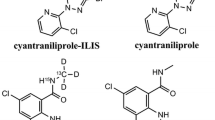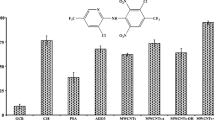Abstract
Free phenolic acids present in cereal malts serve as precursors of different volatile compounds in beer. To study their generation from wheat and barley on the way to the respective malts, stable isotope dilution assays (SIDAs) were developed using high-performance liquid chromatography–tandem mass spectrometry to quantitate the free phenolic acids caffeic, cinnamic, p-coumaric, ferulic, sinapic, and vanillic acid in the grain as well as in the malts produced thereof. An optimised extraction procedure using methanol instead of water in combination with the newly developed SIDAs enabled their selective and sensitive quantitation with low limits of detection and limits of quantitation as well as good recoveries. In kiln-dried wheat malt, the most abundant free phenolic acid was sinapic acid with 2.30 mg/kg dry mass, while in kiln-dried barley malt ferulic acid predominated with 2.76 mg/kg dry mass. The concentration of the latter in kiln-dried malt is of special interest, because this acid is a well-known precursor of the important wheat beer aroma compound 2-methoxy-4-vinylphenol. The concentration of cinnamic acid, the precursor of the toxicologically relevant vinylbenzene (styrene), in kiln-dried wheat and barley malt were 0.56 and 0.97 mg/kg dry mass, respectively. Generally, kiln-dried barley malt showed higher concentrations of most phenolic acids in comparison to kiln-dried wheat malt.




Similar content being viewed by others
References
Nordkvist E, Salomonsson AC, Aaman P (1984) Distribution of insoluble bound phenolic acids in barley grain. J Sci Food Agric 35:657–661
Sancho AI, Faulds CB, Bartolome B, Williamson G (1999) Characterization of feruloyl esterase activity in barley. J Sci Food Agric 79:447–449
Maillard M-N, Berset C (1995) Evolution of antioxidant activity during kilning: role of insoluble bound phenolic acids of barley and malt. J Agric Food Chem 43:1789–1793
Maillard M-N, Soum M-H, Boivin P, Berset C (1996) Antioxidant activity of barley and malt: relationship with phenolic content. Food Sci Tech 29:238–244
Cuvelier ME, Richard H, Berset C (1992) Comparison of the antioxidative activity of some acid-phenols: structure–activity relationship. Biosci Biotechnol Biochem 56:324–325
Wackerbauer K, Kraemer P, Siepert J (1982) Phenolic aromatic substances in beer. Phenolic carboxylic acid and phenols in the raw material and beer preparation. Brauwelt 122:618–626 (in German)
Fiddler W, Parker WE, Wasserman AE, Doerr RC (1967) Thermal decomposition of ferulic acid. J Agric Food Chem 15:757–761
Goodey AR, Tubb RS (1982) Genetic and biochemical analysis of the ability of Saccharomyces cerevisiae to decarboxylate cinnamic acids. J Gen Microbiol 128:2615–2620
Langos D, Granvogl M, Schieberle P (2013) Characterization of the key aroma compounds in two Bavarian wheat beers by means of the Sensomics approach. J Agric Food Chem 61:11303–11311
IARC WHO International Agency for Research on Cancer (2002) IARC monographs on the evaluation of carcinogenic risks to humans: some traditional herbal medicines, some mycotoxins, naphthalene and styrene, vol 82. IARC WHO, Lyon, France
Daly B, Collins E, Madigan D, Donnelly D, Coakley M, Ross P (1997) An investigation into styrene in beer. In: Proceedings of the congress—26th European brewery convention, 1997. Oxford University Press, Oxford, pp 623–630
Schwarz KJ, Stuebner R, Methner F-J (2012) Formation of styrene dependent on fermentation management during wheat beer production. Food Chem 134:2121–2125
Schwarz KJ, Boitz LI, Methner F-J (2012) Enzymatic formation of styrene during wheat beer fermentation is dependent on pitching rate and cinnamic acid content. J Inst Brew 118:280–284
Woffenden HM, Ames JM, Chandra S, Anese M, Nicoli MC (2002) Effect of kilning on the antioxidant and pro-oxidant activities of pale malts. J Agric Food Chem 50:4925–4933
Samaras TS, Camburn PA, Chandra SX, Gordon MH, Ames JM (2005) Antioxidant properties of kilned and roasted malts. J Agric Food Chem 53:8068–8074
Inns EL, Buggey LA, Booer C, Nursten HE, Ames JM (2007) Effect of heat treatment on the antioxidant activity, color, and free phenolic acid profile of malt. J Agric Food Chem 55:6539–6546
Dvorakova M, Guido LF, Dostalek P, Skulilova Z, Moreira MM, Barros AA (2008) Antioxidant properties of free, soluble ester and insoluble-bound phenolic compounds in different barley varieties and corresponding malts. J Inst Brew 114:27–33
Inns EL, Buggey LA, Booer C, Nursten HE, Ames JM (2011) Effect of modification of the kilning regimen on levels of free ferulic acid and antioxidant activity in malt. J Agric Food Chem 59:9335–9343
Dvorakova M, Douanier M, Jurkova M, Kellner V, Dostalek P (2008) Comparison of antioxidant activity of barley (Hordeum vulgare L.) and malt extracts with the content of free phenolic compounds measured by high performance liquid chromatography coupled with CoulArray detector. J Inst Brew 114:150–159
Lu Y, Luthria D, Fuerst EP, Kiszonas AM, Yu L, Morris CF (2014) Effect of processing on phenolic composition of dough and bread fractions made from refined and whole wheat flour of three wheat varieties. J Agric Food Chem 62:10431–10436
Nicoletti I, Martini D, De Rossi A, Taddei F, D’Egidio MG, Corradini D (2013) Identification and quantification of soluble free, soluble conjugated, and insoluble bound phenolic acids in Durum wheat (Triticum turgidum L. var. durum) and derived products by RP-HPLC on a semimicro separation scale. J Agric Food Chem 61:11800–11807
Bonoli M, Marconi E, Caboni MF (2004) Free and bound phenolic compounds in barley (Hordeum vulgare L.) flours. J Chromatogr A 1057:1–12
Zhao H, Dong J, Lu J, Chen J, Li Y, Shan L, Lin Y, Fan W, Gu G (2006) Effects of extraction solvent mixtures on antioxidant activity evaluation and their extraction capacity and selectivity for free phenolic compounds in barley (Hordeum vulgare L.). J Agric Food Chem 54:7277–7286
Slade AM, Hoj PB, Morrice NA, Fincher GB (1989) Purification and characterization of three (1 → 4)-β-d-xylan endohydrolases from germinated barley. Eur J Biochem 185:533–539
Vanbeneden N, Gils F, Delvaux F, Delvaux FR (2007) Formation of 4-vinyl and 4-ethyl derivatives from hydroxycinnamic acids: occurrence of volatile phenolic flavour compounds in beer and distribution of Pad1-activity among brewing yeasts. Food Chem 107:221–230
Coghe S, Benoot K, Delvaux F, Vanderhaegen B, Delvaux FR (2004) Ferulic acid release and 4-vinylguaiacol formation during brewing and fermentation: indications for feruloyl esterase activity in Saccharomyces cerevisiae. J Agric Food Chem 52:602–608
Comino P, Collins H, Lahnstein J, Beahan C, Gidley MJ (2014) Characterisation of soluble and insoluble cell wall fractions from rye, wheat and hull-less barley endosperm flours. Food Hydrocolloids 41:219–226
Kim M-J, Hyun J-N, Kim J-A, Park J-C, Kim M-Y, Kim J-G, Lee S-J, Chun S-C, Chung I-M (2007) Relationship between phenolic compounds, anthocyanins content and antioxidant activity in colored barley germplasm. J Agric Food Chem 55:4802–4809
Hura T, Dubert F, Dabkowska T, Stupnicka-Rodzynkiewicz E, Stoklosa A, Lepiarczyk A (2006) Quantitative analysis of phenolics in selected crop species and biological activity of these compounds evaluated by sensitivity of Echinochloa crus-galli. Acta Physiol Plant 28:537–545
Hithamani G, Srinivasan K (2014) Bioaccessibility of polyphenols from wheat (Triticum aestivum), sorghum (Sorghum bicolor), green gram (Vigna radiata), and chickpea (Cicer arietinum) as influenced by domestic food processing. J Agric Food Chem 62:11170–11179
Schwarz KJ, Boitz LI, Methner F-J (2012) Release of phenolic acids and amino acids during mashing dependent on temperature, pH, time, and raw materials. J Am Soc Brew Chem 70:290–295
Schwarz KJ, Boitz LI, Methner F-J (2013) Influence of mashing conditions on the release of precursors of phenolic wheat beer aromas. Brauwelt 153:274–279 (in German)
Acknowledgments
The authors thank Dr. Martina Gastl (Chair of Brewing and Beverage Technology; Technische Universität München, Freising, Germany) for the production of the malts. Further, we also thank Ines Otte and Sami Kaviani-Nejad for performing the HPLC–MS/MS experiments.
Author information
Authors and Affiliations
Corresponding author
Ethics declarations
Conflict of interest
None.
Compliance with Ethics Requirements
The authors; Daniel Langos, Michael Granvogl, Michael Meitinger and Peter Schieberle hereby confirm that this manuscript is performed according and follows the COPE guidelines and has not already been published nor is it under consideration for publication elsewhere. This article does not contain any studies with human or animal subjects.
Rights and permissions
About this article
Cite this article
Langos, D., Granvogl, M., Meitinger, M. et al. Development of stable isotope dilution assays for the quantitation of free phenolic acids in wheat and barley and malts produced thereof. Eur Food Res Technol 241, 637–645 (2015). https://doi.org/10.1007/s00217-015-2492-0
Received:
Revised:
Accepted:
Published:
Issue Date:
DOI: https://doi.org/10.1007/s00217-015-2492-0




